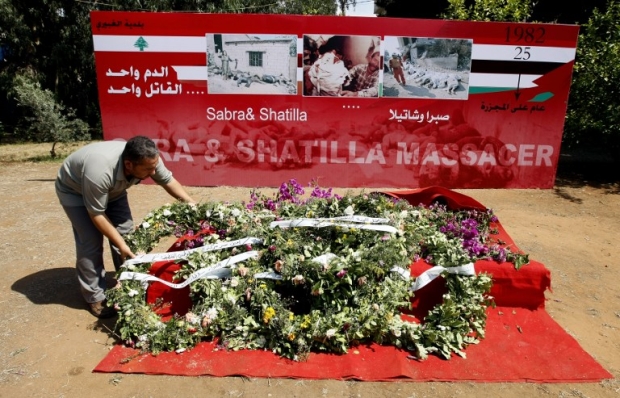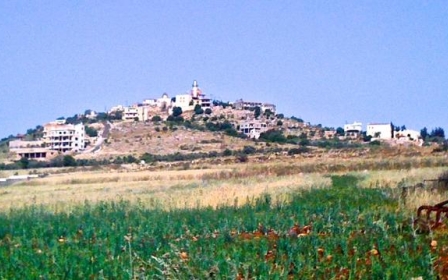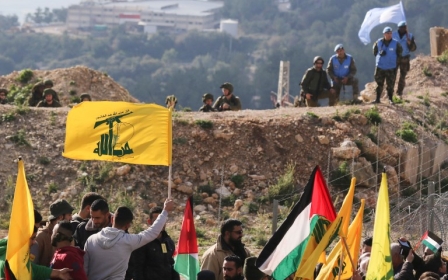Hezbollah ‘missile sites’ and Israel’s precision-guided propaganda

In a typically farcical performance at the United Nations General Assembly on 27 September, Israeli Prime Minister Benjamin Netanyahu took the opportunity to update the world on the alleged activities of his favourite cross-border nemesis: Lebanon’s Hezbollah.
According to Netanyahu’s visual aid - a conspicuously marked diagram - Hezbollah is currently presiding over three secret sites near Beirut’s international airport where, under orders from Tehran, regular old missiles are being converted into precision-guided ones. In other words: the airport and whatever humans might find themselves in the overcrowded vicinity are fair game in any impending conflict.
In response to the allegations, Lebanese Foreign Minister Gebran Bassil accompanied an array of foreign diplomats and journalists on a tour of the supposed missile sites, emphasising his view that Israel is simply seeking to “justify another aggression” against Lebanon - a valid assessment, given Israel’s track record of invading, bombarding and occupying its northern neighbour.
Ethnic cleansing
The tour took place on 1 October, and, as expected, produced no evidence of the missile conversion process.
That same day, the Israeli military tweeted its own opinion that “#Hezbollah has a long history of covering up inconvenient truths and then parading foreign officials around” - a rather brazen claim from a country that has spent the past seven decades covering up the fact that it happens to be founded on a policy of ethnic cleansing and slaughter.
It was none other than this very invasion that prompted the formation of Hezbollah, against which Israel must now 'defend itself' by continuing its murderous antagonisation of Lebanon
As for the business of parading foreign officials around, the whole matter of Israel’s not-so-secret nuclear arsenal comes to mind - which, I dare say, poses a slightly more apocalyptic threat than Hezbollah’s missiles, precision-guided or not.
A 46-second video accompanying the Israeli military tweet begins by reminding us that “three days ago, the Israeli PM exposed [Hezbollah’s] facilities near Beirut’s international airport”.
The video then proceeds to offer some examples of all of the things that can be done over the course of three days, such as fly around the world, climb Mount Meru in Tanzania, “binge on 60 episodes on Netflix”, order and receive a package from Amazon, read a book, travel from Berlin to Prague on foot, and so on.
The upshot, naturally, is that three days is more than enough time to clear out a precision missile factory in Beirut, “invite foreign ambassadors, and hope that the world will fall for it”.
Waves of propaganda
As for what the state of Israel is capable of accomplishing in three days, aside from inundating the internet with propaganda, we might recall a certain three-day Israeli-orchestrated massacre of up to several thousand civilians in the Beirut Palestinian refugee camps of Sabra and Shatila in 1982 - the same year that a particularly bloody Israeli invasion of Lebanon killed some 20,000 people, the vast majority of them civilians.
And guess what: It was none other than this very invasion that prompted the formation of Hezbollah, against which Israel must now “defend itself” by continuing its murderous antagonisation of Lebanon.
The 34-day assault eliminated an estimated 1,200 people in Lebanon, with Israel’s choice of targets ranging from children in a pick-up truck to national highways, bridges and the Beirut airport. It’s thus not totally clear why Israeli officials have, since 2006, felt the need to stipulate that they will no longer distinguish between Lebanon and Hezbollah in any future showdown.
Netanyahu’s airport-missile-site fixation will presumably only assist in the supposedly novel cessation of distinction.
The ‘Shaqra fighting complex’
To be sure, this is hardly the first time the Israelis have unfurled diagrams highlighting the allegedly terroristic features of the Lebanese landscape. Back in 2016, former Israeli ambassador to the United Nations, Danny Danon, presented to the UN Security Council a handy map of the south Lebanese village of Shaqra - pardon, the “Shaqra fighting complex”, as the image was labelled.
Multicoloured markings in between schools, mosques and cemeteries purported to denote the multitude of arms depots, rocket launchers, anti-tank positions and other highlights of Shaqra - none of which I myself have ever managed to stumble across, despite several visits to the diminutive village, though I have observed many schoolchildren, hair salons, farms, bakeries, a Botox establishment, an entity called “Magic Land”, and a painting of Che Guevara.
As we know from Israel’s behaviour in the Gaza Strip, where thousands of Palestinian civilians have been slaughtered over the past decade alone, Arabs are often granted only two identity options: terrorist or human shield. The demise of any human shield at the hand of Israel is automatically the fault of the terrorists.
Forget schoolchildren and Magic Land; the “Shaqra fighting complex” approach symbolically clears the area of anyone with a claim to the title of “civilian”, thereby preemptively exonerating Israel for potential war crimes.
Obviously, the point of taking issue with Israel’s latest anti-Hezbollah agitation is not that Hezbollah doesn’t have weapons; it does, and for good reason, many argue, given the modus operandi of its predatory neighbour.
Predicated on violence
Last month, Hezbollah leader Hassan Nasrallah even boasted of possessing precision missiles - which, again, would appear to be a logical deterrent against established Israeli belligerence.
The point, rather, is that a country that harbours a giant, undeclared nuclear arsenal and has for the past 70 years engaged in all manner of conventional brutality and violence is in no position to be lecturing anyone on anything - diagrams or no diagrams.
Plenty more thought-provoking questions could of course be asked, such as why Israel has utilised flesh-incinerating white phosphorus on civilians [and] massacred unarmed Palestinian protesters
In its video-tweet re the alleged missile production sites, the Israeli military posed the abbreviated question: “Maybe this time ask why missile workshop located so close to int’l #airport in heart of #Beirut?”, followed by the oh-so-hashtag-savvy “#maybethetruththistime”.
Plenty more thought-provoking questions could of course be asked, such as why Israel has utilised flesh-incinerating white phosphorus on civilians, massacred unarmed Palestinian protesters and medics, and jumped at every chance to pave the way for yet more bloodshed.
The short answer in all cases is that the Israeli enterprise is itself predicated on violence - and that’s the enduring truth.
- Belen Fernandez is the author of The Imperial Messenger: Thomas Friedman at Work, published by Verso. She is a contributing editor at Jacobin magazine.
The views expressed in this article belong to the author and do not necessarily reflect the editorial policy of Middle East Eye.
Photo: Israeli Prime Minister Benjamin Netanyahu addresses the UN General Assembly in New York on 27 September 2018 (AFP)
Stay informed with MEE's newsletters
Sign up to get the latest alerts, insights and analysis, starting with Turkey Unpacked
Middle East Eye delivers independent and unrivalled coverage and analysis of the Middle East, North Africa and beyond. To learn more about republishing this content and the associated fees, please fill out this form. More about MEE can be found here.






